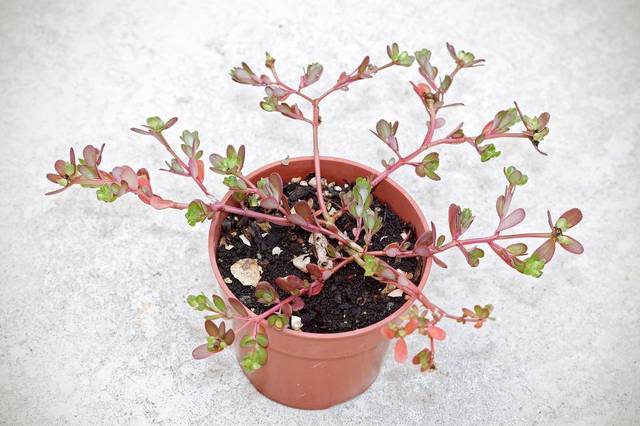What’s that weed? Edible purslane

BY KENNETH SETZER
As published in the Miami Herald, 7/3/15.
Don’t you wish growing edibles was like growing weeds? It can be. What is a weed, really, but a plant growing where we don’t want it to grow? Many weeds, it turns out, are indeed edible. Here’s a weed you can eat, is fairly attractive, and has an interesting history: Purslane (Portulaca oleracea).

The late onset of rain this year has left our lawns of centipede grass (Eremochloa ophiuroides) dormant, brown and sparse, giving other plants the chance to colonize without much competition.
Look around at these sparse areas and you are bound to spot some red among the green and brown. Purslane, with its distinctive red stems, small button leaves, and miniature yellow flowers, grows in the lawn’s bare patches, as well as between cracks in the sidewalk and other inhospitable places.
Purslane is an annual succulent, evolved to grow in dry places and tolerate periods of drought, though unlike some other succulents, does not seem perturbed by heavy rains that cause most aridity-loving succulents to rot. Its taproot extends deeply into rocky, unfertile soil as well as deeply into human history, so to speak.
Roman naturalist Pliny the Elder mentioned purslane in his Natural History nearly 2,000 years ago. Cultivated varieties in seed catalogs were available in the U.S. as early as 1800. A half century later, Thoreau ate it “boiled and salted” while in the woods.
For the most part, the young stems and leaves are the edible parts, though it’s fine to include the flowers. Many sources liken the taste to spinach, slightly bitter or acidic. Interestingly, purslane picked at night or during early morning may be more bitter than that harvested later in the day because of a higher level of malic acid.
Purslane is eaten raw in salads, or simply with olive oil and salt. Greek salads employ purslane with feta and olive oil to great effect. There are recipes for frying it as one would okra, or cooking it in soups. Like okra, it is mucilaginous, though not slimy. The mucilage it produces, like that of aloe, is said to have medicinal benefits and has been used in many traditional medicines from India to China.
Purslane has been traditionally considered native to the Old World, from Africa to Asia, but a plant that reproduces so readily — and has been spread by humans for millennia — is challenging to trace back to a source. The great botanist Asa Gray suggested that Vikings brought it with them to the New World via Greenland and Iceland; however purslane does not grow in those places. Research on lake sediment in Ontario, Canada, found purslane pollen and seeds from around 1350, long before the crucial date of 1492, so it may indeed be a native plant.
Purslane is rich in alpha-Linolenic acid (an omega-3 fatty acid), vitamins A, C and B, as well as beta carotene, and plant pigments shown to have anti-mutagenic properties, meaning they may inhibit cells from mutating, according to the National Center for Biotechnology Information.
The USDA provides more details on their extensive nutrient database. Search for purslane at http://ndb.nal.usda.gov/. I am neither a nutritionist nor a wild foods expert, so consult an actual field guide before you pick and eat anything.
As a companion plant, purslane provides ground cover, retains humidity and the deep taproot breaks through difficult soil and extracts nutrients nearby plants can use. A cosmopolitan weed you can eat — can’t ask for much more than that!
